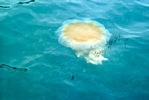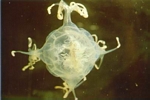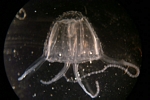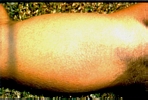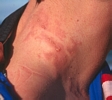|
| Jellyfish Species: |
|
|
 |
Physalia utriculus (“Bluebottle”) |
 |
Physalia physalis (“Pacific Man-o’-war”) |
 |
Cyanea (“Hair Jellyfish”) |
 |
Catostylus (“Blubber”) |
 |
“Sea lice” |
|
|
|
|
| Dangerous or Lethal Species: |
|
|
|
Chironex box jellyfish (“Box-Jellyfish”) |
|
Irukandji (Carukia barnesi) |
|
|
| Other Species: |
|
|
|
Tamoya (“Morbakka” or “Fire Jelly”) |
|
Carybdea rastoni (“Jimble”) |
|
Pelagia (“Little Mauve Stinger”) |
|
Chrysaora species – “Sea Nettle” |
|
FIRST AID TREATMENT OF CHIRONEX & OTHER BOX JELLYFISH STINGS |
|
 Physalia utriculus Physalia utriculus
DISTRIBUTION
Australia-wide, and in most worldwide warm oceans.
OTHER COMMON NAMES
“Bluebottle”.
SIZE AND APPEARANCE
Air filled sac up to 8 cms in length, with a single long blue tentacle hanging underneath. This may contract to a few centimetres, or extend to over a metre in length.
SYMPTOMS & SIGNS
 |
Burning skin pain.
|
 |
Usually single raised white wheal with prominent `beading’ effect. Multiple wheals may occur with mass stinging.
|
 |
Pain in draining lymph glands (groin if sting is on legs, axilla if sting is on arms.
|
TREATMENT:
 |
Wash off any adherent tentacles with salt water.
|
 |
Apply a cold pack over a tissue or cloth, or apply ice wrapped in a wet cloth over the sting site for 10-20 minutes.
|
 |
Reassess pain, then reapply cold pack or ice if necessary. Send for medical aid if cold fails to relieve pain, or other symptoms develop.
|
 Physalia physalis Physalia physalis
DISTRIBUTION
Most World-wide warm oceans.
OTHER COMMON NAMES
“Portuguese Man-o’-war”, “Pacific Man-o’-war”.
SIZE AND APPEARANCE
Air filled sac up to 25 cms in length, with a multiple long blue tentacles hanging underneath. These may contract to a few metres, or extend to over 30 metre in length.
SYMPTOMS & SIGNS
 |
Burning skin pain.
|
 |
Multiple raised white wheals with or without prominent `beading’ effect.
|
 |
Nausea, vomiting.
|
 |
Severe muscle pains.
|
 |
Chest pains and breathing difficulty.
|
(There have been three deaths from “Portuguese man-o’-war” stings in the U.S.A.).
TREATMENT:
 |
Wash off any adherent tentacles with salt water.
|
 |
Apply a cold pack over a tissue or cloth, or apply ice wrapped in a wet cloth over the sting site for 10-20 minutes.
|
 |
Reassess pain, then reapply cold pack or ice if necessary. Send for medical aid if cold fails to relieve pain, or other symptoms develop.
|
 Cyanea sp. – “Hair Jellyfish” Cyanea sp. – “Hair Jellyfish”
DISTRIBUTION
Worldwide.
OTHER COMMON NAMES
“Hair jelly”, “Snottie”.
SIZE AND APPEARANCE
Large flat bell 4-30 cms in diameter with a large “mop” of fine, hair-like tentacles 5-50 cms. long hanging underneath. Bell top is usually white, but with yellow or brown colouring under bell.
|
|
|
|
|
SYMPTOMS & SIGNS
 |
Usually minor skin burning, occasionally more severe skin pain.
|
 |
red zigzag lines or irregular raised white whelts with red surround.
|
TREATMENT
 |
Wash off any adherent tentacles with salt water.
|
 |
Apply a cold pack over a tissue or cloth, or apply ice wrapped in a wet cloth over the sting site for 10-20 minutes.
|
 |
Reassess pain, then reapply cold pack or ice if necessary. Send for medical aid if cold fails to relieve pain, or other symptoms develop.
|
 Catostylus – “Blubber” Catostylus – “Blubber”
DISTRIBUTION
Worldwide.
OTHER COMMON NAMES
“blubber”.
SIZE AND APPEARANCE
Mushroom-shaped bell 5-30 cms. diameter.
No tentacles but eight “fronds” or “frills” hanging underneath.
SYMPTOMS & SIGNS
 |
Minor skin irritation.
|
TREATMENT
 |
Wash off any adherent tentacles with salt water.
|
 |
Apply a cold pack over a tissue or cloth, or apply ice wrapped in a wet cloth over the sting site for 10-20 minutes.
|
 |
Reassess pain, then reapply cold pack or ice if necessary. Send for medical aid if cold fails to relieve pain, or other symptoms develop.
|
 “Sea Lice” “Sea Lice”
This is a “loose” term applied to minor skin stings occurring almost any time or any place whilst swimming in the sea. An actual sea creature or jellyfish does not cause the stings, but fine netting of the water and the use of a face mask at these times has shown a number of possible culprits, including:-
 |
Small jelly-like creatures such as Hydroids, Salps and Ctenophores (“sea gooseberries” and “comb jellies”).
|
 |
Small, broken-off jellyfish tentacles.
|
 |
Glaucus – a small creature that was found in the water on one occasion after a large number of minor stings. This tiny mollusc eats jellyfish tentacles and uses them to sting its own prey!
|
TREATMENT
 |
Apply a cold pack over a tissue or cloth, or apply ice wrapped in a wet cloth over the sting site for 10-20 minutes.
|
 Chironex fleckeri (Chironex Box Jellyfish) Chironex fleckeri (Chironex Box Jellyfish)
DISTRIBUTION
Shallow, Tropical Australian waters (north of Agnes Waters, Qld, all N.T. and Western Australia north of Exmouth). A mainly coastal jellyfish ? may be found on Islands near the coast but not found offshore.
SIZE AND APPEARANCE
Box-shaped bell with 4 corners up to 30cm diameter. From the corners up to 15 ribbon-like tentacles arise. These may be contacted of about 10 cms., or may extend up to 3 meters in length.
|
|
OTHER COMMON NAMES
“Box-jellyfish”. Often referred to as ?Stingers?, rarely as the “Sea wasp”. These latter names should NOT be used – the word ?Stingers? can mean any stinging jellyfish in the sea and we must be more specific as this jellyfish causes severe stings and even death. The second name is old-fashioned and confuses people ? making them think that this is a creatures that flies over the water rather than exists below it.
SYMPTOMS & SIGNS
 |
Instant, and severe burning skin pain. Sting marks look like whip marks, or may resemble burn marks on the skin.
|
 |
Adherent tentacles are often still present.
|
 |
`Frosted-ladder’ pattern may be visible.
|
 |
Victim may rapidly lose consciousness and stop breathing.
|
 |
The pulse may become irregular, or stop.
|
 FIRST AID TREATMENT OF CHIRONEX & OTHER BOX JELLYFISH STINGS FIRST AID TREATMENT OF CHIRONEX & OTHER BOX JELLYFISH STINGS
First aid treatment of chirodropid envenomation:
|

|
1. Retrieve the victim from the water and restrain them, if necessary.
|
|

|
2. If others are available, immediately send them for ambulance / medical help (emphasise the sting is from a Box jellyfish as the Ambulance may have antivenom available).
|
 |
3. Check the victims Airway, breathing and circulation (ABC). Treat with mouth-to-mouth resuscitation (EAR), or heart massage (CPR), if necessary.
|
 |
4. If others are available, or if resuscitation is not needed, pour vinegar over the stung area for a minimum of 30 seconds to inactivate remaining stinging cells on any adherent tentacles left on the skin.
|
 |
5. AFTER vinegar application, for SMALLER* stings, then: –
a) apply cold packs or ice, wrapped in a polythene bag. This greatly helps the burning pain but takes a little longer than usual to work (because of the severity of the skin pain).
b) Compression bandages and immobilisation (pressure immobilisation bandaging) is unnecessary.
* A Major sting is defined below, smaller stings are for the stings that cannot be classed as ?major?. Major stings are rare.
Definition of a MAJOR sting is one: –
a) covering an area more than half of one limb
b) causing impairment of consciousness (i.e. drowsy or unresponsive)
c) causing impairment of breathing (poor breathing effort)
d) causing impairment of circulation (weak or irregular pulse)
TREATMENT of a MAJOR STING:
Steps 1-4 above, as before (i.e. after vinegar application for 30 secs),
5) apply compression bandages – firstly, directly over stung area, then apply compression bandage from the toes to the groin and immobilise the limb (tie both legs together, preferably with splint between the two) ? i.e. pressure immobilisation bandaging. The pressure of the bandage is about the same as one applied to a sprained ankle. |
 |
6. If available, use CSL Chironex antivenom for all major cases (see above). Three ampoules each containing 20, 000 units may be given intramuscularly, above the bandages, by a trained health professional on the beach. One ampoule intravenously may be given by medical personnel.
Again, make sure someone has phoned for the ambulance and requested antivenom (only Queensland State Ambulance carry Chironex antivenom). |
 |
7. Cold packs may be used (15 minutes and repeated when necessary) to help ease the skin pain in conscious victims.
|
 |
8. In severe envenomation, use oxygen if available; Inhaled analgesia (ie entonox or penthrane) can be administered for unremitting pain in conscious, breathing, cooperative patients; its use should be discontinued if the patient’s condition worsens.
If vinegar is unavailable, the rescuer should pull tentacles off using their fingers (only a faint, harmless prickling will be felt) – before applying the compression bandages. REMEMBER to wash your hands after this as sting cells will remain on your fingers until they are carefully washed off! |
 “Irukandji” Stings “Irukandji” Stings
(for further information on Irukandji click here )
DISTRIBUTION
Tropical Australian and Indo-Pacific waters. Found out to sea, and on Great Barrier Reef. At times may occur in “epidemic proportions” close to shore.
SIZE AND APPEARANCE
Small transparent jellyfish, usually never seen. A box-shape’ jellyfish 1.5-2.5cms across bell with 1 tentacle only in each corner. The tentacles may be a few centimeters to 60cms. in length.
SYMPTOMS & SIGNS
 |
Initial minor sting. The stung area may have “goose-pimples” or localised sweating.
|
 |
The sting is followed by a characteristic time delay of 5-40 minutes (usually 25-30mins.)
|
 |
After the delay then severe backache, muscle cramps, sweating, nausea, headache and a dreadful feeling of anxiety and ill health occur.
|
TREATMENT OF IRUKANDJI STINGS
 |
Application of vinegar for 30 secs
|
 |
Observation of airway, breathing, circulation.
|
 |
Rest and re-assurance.
|
 |
Send for ambulance / medical aid.
|
 |
Transfer to Hospital.
|
 TAMOYA sp. TAMOYA sp.
DISTRIBUTION
Tropical Australian waters, all Qld. and northern NSW coasts – usually an `open-water’ jellyfish.
OTHER COMMON NAMES
“Morbakka”, “Fire Jelly”, “Moreton Bay Stinger”.
SIZE AND APPEARANCE
Large transparent box-shaped jellyfish with one tentacle in each corner. Bell 6-18 cms height having thick, ribbon-shaped tentacles that may be up to 1 meter long.
SYMPTOMS & SIGNS
 |
Burning, itchy pain at sting site.
|
 |
Wide, raised pink wheals with surrounding bright red skin flare.
|
 |
Rarely an “Irukandji-type” syndrome may occur.
|
TREATMENT:
 |
Douse any adherent tentacles with vinegar.
|
 |
Cold pack applied over a tissue or cloth, or apply ice wrapped in a wet cloth directly over the sting site for 10-20 minutes.
|
 |
Reassess pain, then reapply cold pack or ice if necessary.
|
 |
Send for medical assessment if cold fails to relieve pain, or other symptoms develop.
|
 Carybdea rastoni – “Jimble” Carybdea rastoni – “Jimble”
DISTRIBUTION
Australia-wide.
SIZE AND APPEARANCE
Transparent bell with diameter 1.5-3.0cm. Four tentacles, one in each corner,
5-30cm long.
SYMPTOMS & SIGNS
 |
Thin, raised white wheals surrounded by bright red flare. Itchy, but USUALLY with little skin pain.
|
 |
Occasionally quite marked local skin pain.
|
TREATMENT
 |
Douse any adherent tentacles with vinegar (usually there are none present).
|
 |
Cold pack applied over a tissue or cloth, or apply ice wrapped in a wet cloth directly over the sting site for 10-20 minutes.
|
 |
Reassess pain, then reapply cold pack or ice if necessary.
|
 |
Send for medical assessment if cold fails to relieve pain, or other symptoms develop.
|
 Pelagia sp. – “Little Mauve Stinger” Pelagia sp. – “Little Mauve Stinger”
DISTRIBUTION
Although this jellyfish is very common in the Mediterranean, where it may appear in plague proportions, in recent years it appears to be less common in Australian waters.
SIZE AND APPEARANCE
A small mushroom-shaped body from 4-12cm in diameter. Unlike most jellyfish, the bell is covered with numerous warty lumps containing nematocysts (stinging cells). It is one of the few jellyfish in which contact with the bell may cause a sting. The bell is usually a pink or mauve with 8 pale brown tentacles 10-30 cm. in length.
SYMPTOMS & SIGNS
 |
The sting is usually locally painful in the stung area, and has irregular shaped raised wheal, looking like an allergic reaction.
|
 |
Sometimes painful, or difficult breathing may occur.
|
TREATMENT
 Chrysaora sp. – “Sea Nettle” Chrysaora sp. – “Sea Nettle”
DISTRIBUTION
Common Worldwide, but less common in Australia. Described in Cockburn Sound, Swan River and Perth beaches in Western Australia.
SIZE AND APPEARANCE
Up to 25cm bell diameter and 24 tentacles around the margin.
SYMPTOMS AND SIGNS
 |
An unpleasant sting that causes a burning skin pain, burning throat, coughing and possibly a profuse watery nasal discharge.
|
TREATMENT
 |
Cold pack applied over a tissue or cloth, or apply ice wrapped in a wet cloth directly over the sting site for 10-20 minutes.
|
 |
Reassess pain, then reapply cold pack or ice if necessary.
|
 |
Send for medical assessment if cold fails to relieve pain, or other symptoms develop.
|
 Chrysaora sp. – “Sea Nettle” Chrysaora sp. – “Sea Nettle”
DISTRIBUTION
Common Worldwide, but less common in Australia. Described in Cockburn Sound, Swan River and Perth beaches in Western Australia.
SIZE AND APPEARANCE
Up to 25cm bell diameter and 24 tentacles around the margin.
SYMPTOMS AND SIGNS
 |
An unpleasant sting that causes a burning skin pain, burning throat, coughing and possibly a profuse watery nasal discharge.
|
TREATMENT
 |
Cold pack applied over a tissue or cloth, or apply ice wrapped in a wet cloth directly over the sting site for 10-20 minutes.
|
 |
Reassess pain, then reapply cold pack or ice if necessary.
|
 |
Send for medical assessment if cold fails to relieve pain, or other symptoms develop.
|
|







